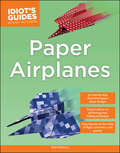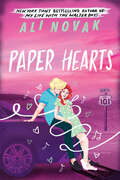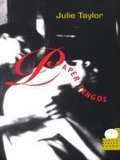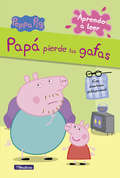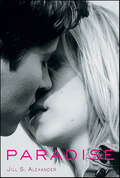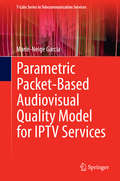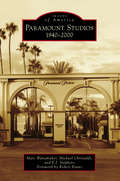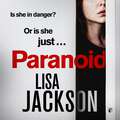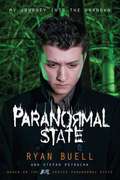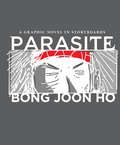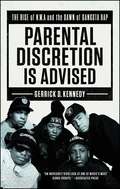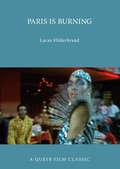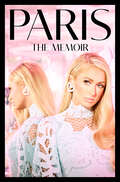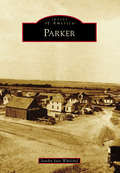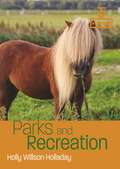- Table View
- List View
Paper Airplanes (Idiot's Guides)
by Nick RobinsonRelated to origami, paper airplanes originated from China and are toys devised entirely out of paper and adhesives (sometimes glue or tape) that utilize an aerodynamic shape to lift and soar. Idiot's Guides: Paper Airplanes features 20 of the coolest designs-- and offers easy-to-understand, step-by-step instructions. This book includes:- Step-by-step easy-to-understand illustrated folding instructions, including the level of cutting/folding difficulty, flight pattern, and durability levels to the corresponding airplanes. - 20 symmetric models, ranging in difficulty levels, which are illustrated within the colorful guide.- 80 sheets of eye-catching, pre-designed printed 8.5x11 paper for readers to practice with and create planes.- Cool backgrounds that highlight each of the airplane projects.
Paper Hearts (The Heartbreak Chronicles #2)
by Ali NovakFrom beloved Wattpad sensation Ali Novak, author of My Life with the Walter Boys, comes this never-before-published companion to The Heartbreakers, perfect for fans of Jenny Han and Kasie West"I'm sorry," he said, slowly untying the ribbon that held his mask in place. "It's just—I didn't want you to think of me any differently." Somehow I kept my mouth from falling open. I knew his face, but my mind couldn't accept that he was the person looking down at me. "My real name is Alec."Felicity has her entire future planned. Ever since her older sister ran away, she's had the full weight of her mother's expectations on her shoulders. So she works hard to get straight As and save for college.Except sometimes the best things in life are unplanned—like when Felicity meets a handsome, masked stranger while she is volunteering at a charity masquerade ball. She never thought he'd flirt with her. And she certainly never thought he'd turn out to be a member of the world-famous Heartbreakers band, Alec.Then Felicity uncovers a shocking family secret. Suddenly, she, Alec, and her two best friends are off on a road trip to find Felicity's missing sister. And she's about to discover that unexpected turns have a peculiar way of landing her right where she needs to be…With a perfect balance of humor, heart, and romance, Paper Hearts is a great choice for readers looking for:fun contemporary romance for teensswoon-worthy Wattpad love storiesromcoms that cover deeper issues like family and self-discoverybinge-worthy YA novels
Paper Tangos
by Julie TaylorTango. A multidimensional expression of Argentine identity, one that speaks to that nation's sense of disorientation, loss, and terror. Yet the tango mesmerizes dancers and audiences alike throughout the world. In Paper Tangos, Julie Taylor--a classically trained dancer and anthropologist--examines the poetics of the tango while describing her own quest to dance this most dramatic of paired dances.Taylor, born in the United States, has lived much of her adult life in Latin America. She has spent years studying the tango in Buenos Aires, dancing during and after the terror of military dictatorships. This book is at once an account of a life lived crossing the borders of two distinct and complex cultures and an exploration of the conflicting meanings of tango for women who love the poetry of its movement yet feel uneasy with the roles it bestows on the male and female dancers. Drawing parallels among the violences of the Argentine Junta, the play with power inherent in tango dancing, and her own experiences with violence both inside and outside the intriguing tango culture, Taylor weaves the line between engaging memoir and insightful cultural critique. Within the contexts of tango's creative birth and contemporary presentations, this book welcomes us directly into the tango subculture and reveals the ways that personal, political, and historical violence operate in our lives.The book's experimental design includes photographs on every page, which form a flip-book sequence of a tango. Not simply a book for tango dancers and fans, Paper Tangos will reward students of Latin American studies, cultural studies, anthropology, feminist studies, dance studies, and the art of critical memoir.
Papá pierde las gafas (Peppa Pig. Pictogramas)
by Varios AutoresEn esta divertida historia te contamos lo que pasó cuando Papá Pig perdió sus gafas. ¡Descubre cómo logramos encontrarlas! Papá Pig está leyendo el periódico y no encuentra sus gafas. Peppa y George se ofrecen para ayudarle a buscarlas. Descubre dónde encuentra Peppa las gafas. ¡Para que los más peques se diviertan leyendo esta historia con pictogramas y aprendiendo el vocabulario!
Parade
by Donald CrewsShowing the same dynamic energy and brilliant colors as in <i>Freight Train</i> and <i>Truck</i>, Donald Crews conveys the breathless anticipation and delighted enjoyment generated by a parade in this book.
Paradise
by Jill S. AlexanderPaisley Tillery is the drummer for a country rock band. If they can make it to the stage at the Texapalooza music fest, then Paisley will be closer to her dream of a career in music and a ticket out of her small Texas town. Drumming and music are what Paisley has always wanted. Until the band gets a new lead singer, the boy from Paradise, Texas. With Paradise in her life, what Paisley wants, and what she needs, complicate her dreams coming true.
Paradoxical Right-Wing Sexual Politics in Europe (Global Queer Politics)
by Cornelia Möser Jennifer Ramme Judit TakácsHow did far-right, hateful and anti-democratic ideologies become so successful in many societies in Europe? This volume analyses the paradoxical roles sexual politics have played in this process and reveals that the incoherence and untruthfulness in right-wing populist, ultraconservative and far-right rhetorics of fear are not necessarily signs of weakness. Instead, the authors show how the far right can profit from its own incoherence by generating fear and creating discourses of crisis for which they are ready to offer simple solutions. In studies on Poland, Hungary, Spain, Italy, Austria, Ireland, Northern Ireland, Portugal, France, Sweden and Russia, the ways far-right ideologies travel and take root are analysed from a multi-disciplinary perspective, including feminist and LGBTQI reactions. Understanding how hateful and antidemocratic ideologies enter the very centre of European societies is a necessary premise for developing successful counterstrategies.
Parallel Lines
by Guy WestwellParallel Lines describes how post-9/11 cinema, from Spike Lee's 25th Hour (2002) to Kathryn Bigelow's Zero Dark Thirty (2012), relates to different, and competing, versions of US national identity in the aftermath of the September 11th terrorist attacks. The book combines readings of individual films (World Trade Center, United 93, Fahrenheit 9/11, Loose Change) and cycles of films (depicting revenge, conspiracy, torture and war) with extended commentary on recurring themes, including the relationship between the US and the rest of the world, narratives of therapeutic recovery, questions of ethical obligation.The volume argues that post-9/11 cinema is varied and dynamic, registering shock and upheaval in the immediate aftermath of the attacks, displaying capacity for critique following the Abu Ghraib prisoner abuse scandal mid-decade, and seeking to reestablish consensus during Obama's troubled second term of office.
Parallel Lines: Post-9/11 American Cinema
by Guy WestwellDescribes how post-9/11 cinema, from Spike Lee's 25th Hour (2002) to Kathryn Bigelow's Zero Dark Thirty (2012), relates to different, and competing, versions of US national identity in the aftermath of the September 11th terrorist attacks
Parallel Lines: Post-9/11 American Cinema
by Guy WestwellParallel Lines describes how post-9/11 cinema, from Spike Lee's 25th Hour (2002) to Kathryn Bigelow's Zero Dark Thirty (2012), relates to different, and competing, versions of US national identity in the aftermath of the September 11 terrorist attacks. The book combines readings of individual films (World Trade Center, United 93, Fahrenheit 9/11, Loose Change) and cycles of films (depicting revenge, conspiracy, torture and war) with extended commentary on recurring themes, including the relationship between the US and the rest of the world, narratives of therapeutic recovery, questions of ethical obligation.The volume argues that post-9/11 cinema is varied and dynamic, registering shock and upheaval in the immediate aftermath of the attacks, displaying capacity for critique following the Abu Ghraib prisoner abuse scandal mid-decade, and seeking to reestablish consensus during Obama's troubled second term of office.
Parametric Packet-based Audiovisual Quality Model for IPTV services
by Marie-Neige GarciaThis volume presents a parametric, packet-based, comprehensive model to measure and predict the audiovisual quality of Internet Protocol Television services as it is likely to be perceived by the user. The comprehensive model is divided into three sub-models referred to as the audio model, the video model, and the audiovisual model. The audio and video models take as input a parametric description of the audiovisual processing path, and deliver distinct estimates for both the audio and video quality. These distinct estimates are eventually used as input data for the audiovisual model. This model provides an overall estimate of the perceived audiovisual quality in total. The parametric description can be used as diagnostic information. The quality estimates and diagnostic information can be practically applied to enhance network deployment and operations. Two applications come to mind in particular: Network planning and network service quality monitoring. The audio model can be used indifferently for both applications. However, two variants of the video model have been developed in order to address particular needs of the applications mentioned above. The comprehensive model covers effects due to resolution, coding, and IP-packet loss in case of RTP-type transport. The model applied to quality monitoring is standardized under the ITU-T Recommendations P. 1201 and P. 1201. 2.
Paramount Studios: 1940-2000 (Images of America)
by Robert Evans Marc Wanamaker E. J. Stephens Michael ChristaldiThe fascinating tale of Hollywood powerhouse Paramount Pictures--beginning with its birth in the 1910s through the turbulent decade of the 1930s--was told in Early Paramount Studios by Marc Wanamaker, Michael Christaldi, and E.J. Stephens. Now the same authors are back to tell the next 60 years of the studio saga in Paramount Studios: 1940-2000, with a foreword by former Paramount head of production Robert Evans. This book picks up the story during the time of World War II--a successful era for the studio--which was followed by a decade of decline due to the upstart medium of television. By the 1960s, the studio teetered on the brink of bankruptcy before rebounding, thanks to several 1970s blockbusters, such as Love Story, The Godfather, and Chinatown. The tale continues through the final decades of the 20th century when Paramount showcased some of the greatest hits in its history.
Paramount: City of Dreams
by Steven BingenParamount: City of Dreams brings to life the operations of the world&’s grandest movie lot as never before by opening its famous gates and revealing – for the first time – the wonderful myriad of soundstages and outdoor sets where, for one hundred years, Paramount has produced the world&’s most famous films. With hundreds and hundreds of rare and unpublished photographs in color and black & white, readers are launched aboard a fun and entertaining &“virtual tour&” of Hollywood&’s first, most famous and most mysterious motion picture studio. Paramount is a self-contained city. But unlike any community in the real world, this city&’s streets and lawns, its bungalows and backlots, will be familiar even to those who have never been there. Now, for the first time, these much-filmed, much-haunted acres will be explored and the mysteries and myths peeled away – bringing into focus the greatest of all of Hollywood&’s legendary dream factories.
Paranoid: The new gripping crime thriller from the bestselling author
by Lisa Jackson'Shiveringly good suspense!' Lisa GardnerTHE BRAND NEW NOVEL FROM LISA JACKSONTwenty years ago, Rachel Gaston accidentally shot and killed her brother in a teenage game that went horribly wrong.Today, Rachel is trying to put the guilt of what happened behind her. But her horrifying dreams about that night continue to stalk her. As the anniversary of her brother's death nears, Rachel feels her imagination playing tricks, convincing her that objects in her house have moved. That there's a hint of unfamiliar cologne in the air. That someone is tailing her car. Watching her home.Rachel has never known the truth about that night. But as connections surface between a new string of murders and Luke's death, she realises there's no escaping the past, and the truth may be darker than her worst fears . . . A fast-paced psychological thriller for fans of Lisa Gardner and Karen Rose, with Lisa Jackson's trademark mix of dark secrets and stunning twists.
Paranormal Media: Audiences, Spirits and Magic in Popular Culture
by Annette HillThe paranormal has gone mainstream.Beliefs are on the rise, with almost half of the British population, and two thirds of Americans, claiming to believe in extra sensory perceptions and hauntings. Psychic magazines like Spirit and Destiny, television shows such as Fringe, Ghost Whisperer and Most Haunted, ghost-cams and e-poltergeists, bestselling books on mind, body and spirit, and magicians like Derren Brown have moved from the outer limits to the centre of popular culture, turning paranormal beliefs and scepticism into revenue streams.Paranormal Media offers a unique, timely exploration of the extraordinary, unexplained and supernatural in popular culture, looking in unusual places in order to understand this phenomenon. Early spirit forms such as magic lantern shows or the spirit photograph are re-imagined as a search for extraordinary experiences in reality TV, ghost tourism, and live shows. Through a popular cultural ethnography, and critical analysis in social and cultural theory, this ground-breaking book by Annette Hill presents an original and rigorous examination of people's experiences of spirits and magic. In popular culture, people are players in an orchestral movement about what happens to us when we die. In a very real sense the audience is the show. This book is the story of audiences and their participation in a show about matters of life and death.Paranormal Media will be a highly interesting read for undergraduate and postgraduate students, as well as academics, on a wide range of television, media, cultural studies, and sociology courses.
Paranormal State: My Journey into the Unknown
by Stefan Petrucha Ryan BuellParanormal State: My Journey Into the Unknown is the official companion book to A&E’s hit series.On every episode of Paranormal State, Ryan Buell and his team of investigators delve deep into the mysterious world of ghosts, demonic disturbances, and sixth-sense sightings that shadows our everyday reality. Now, in this guide to the series, Buell takes fans one step further, revealing the secrets of the show’s most intense cases—as well as some that were never broadcast—and the shocking, never-before-told story of his own brush with the supernatural—the otherworldly experience that first inspired him to found the Paranormal Research Society.And with each case of unexplained phenomena, Ryan shares how the events forced him to confront his own beliefs, the workings of his rational mind, and the very nature of reality.
Parasite: A Graphic Novel in Storyboards
by Bong Joon HoDiscover the illustrations that inspired the historic, OSCAR®-winning film's every shot in this graphic novel drawn by Director Bong Joon Ho himself. So metaphorical: With hundreds of mesmerizing illustrations, Parasite: A Graphic Novel in Storyboards is a behind-the-scenes glimpse at the making of one of the best films in years and a brand-new way to experience a global phenomenon. As part of his unique creative process, Director Bong Joon Ho storyboarded each shot of PARASITE prior to the filming of every scene. Accompanied by the film's dialogue, the storyboards he drew capture the story in its entirety and inspired the composition of the film's every frame and scene. Director Bong has also written a foreword and provided early concept drawings and photos from the set, which take the reader even deeper into the vision that gave rise to this stunning cinematic achievement. Director Bong's illustrations share the illuminating power of his writing and directing. The result is a gorgeous, riveting read and a fresh look at the vertiginous delights and surprises of Bong Joon Ho's deeply affecting, genre-defying story. <P><P> <i>Advisory: Bookshare has learned that this book offers only partial accessibility. We have kept it in the collection because it is useful for some of our members. Benetech is actively working on projects to improve accessibility issues such as these.</i>
Parental Discretion Is Advised: The Rise of N.W.A and the Dawn of Gangsta Rap
by Gerrick D. KennedyExperience the stunning rise, fall, and legacy of N.W.A. and how they put their stamp on pop culture, black culture, and hip-hop music forever in this &“incredibly vivid look at one of music&’s most iconic groups&” (Associated Press).In 1986, a group was formed that would establish the foundation of gangsta rap and push the genre forward, electrifying fans with their visceral and profane lyrics that glorified the dark ways of street life and brazenly challenged the police system. Eazy-E, Dr. Dre, Ice Cube, MC Ren, and DJ Yella caused a seismic shift in hip-hop when they decided to form N.W.A in 1986. With their hard-core image, bombastic sound, and lyrics that were equal parts poetic, lascivious, conscious, and downright in-your-face, N.W.A spoke the truth about life on the streets of Compton, California—then a hotbed of poverty, drugs, gangs, and unemployment. Going beyond the story portrayed in the 2015 blockbuster movie Straight Outta Compton, through firsthand interviews, extensive research, and top-notch storytelling, Los Angeles Times music reporter Gerrick Kennedy transports you back in time and offers a front-row seat to N.W.A&’s early days and the drama and controversy that followed the incendiary group as they rose to become multiplatinum artists. Kennedy leaves nothing off the table in his pursuit of the full story behind the group&’s most pivotal moments, such as Ice Cube&’s decision to go solo after their debut studio album became a smash hit; their battle with the FBI over inflammatory lyrics; incidents of physical assault; Dr. Dre&’s departure from the group to form Death Row Records with Suge Knight; their impact on the 1992 L.A. riots; Eazy-E&’s battle with AIDS; and much more. A bold, riveting, &“non-stop, can&’t-put-it-down ride&” (Library Journal), Parental Discretion Is Advised unveils the true and astonishing history of one of the most transcendent and controversial musical groups of the 1980s and 1990s.
Parenting Trans and Non-binary Children: Exploring Practices of Love, Support, and Everyday Advocacy
by Magdalena MikulakBased on interviews conducted with parents of trans and gender diverse children in the UK, this book presents an account and analysis of the love, support, and advocacy involved in parenting trans and gender diverse children. Mikulak explores how parents negotiate and challenge cis-normativity to make familial, educational, and healthcare settings livable for their trans and gender diverse children. By examining the educational and emotional labor that parents perform as they advocate for their children across these different settings, the book highlights the value of parental expertise and labor while calling out the systemic failures that continue to make this work necessary. This research will be of interest to scholars researching family studies, kinship studies, gender studies, and queer studies.
Parents' and Teachers' Guide to Music Education
by Roberta MarkelPractical advice on choosing, selecting and buying an instrument, finding a good teacher, learning the language of music, singing, practicing, and careers in music
Paris Is Burning
by Lucas HilderbrandParis Is Burning (Jennie Livingston, 1991) captures the energy, ambition, wit, and struggle of African-American and Latino participants in the 1980s New York drag ball scene. This book contextualizes the film within the longer history of drag balls, the practices of documentary, the fervor of the culture wars, and the development of queer theory and critical race studies.
Paris in the Dark: Going to the Movies in the City of Light, 1930–1950
by Eric SmoodinIn Paris in the Dark Eric Smoodin takes readers on a journey through the streets, cinemas, and theaters of Paris to sketch a comprehensive picture of French film culture during the 1930s and 1940s. Drawing on a wealth of journalistic sources, Smoodin recounts the ways films moved through the city, the favored stars, and what it was like to go to the movies in a city with hundreds of cinemas. In a single week in the early 1930s, moviegoers might see Hollywood features like King Kong and Frankenstein, the new Marlene Dietrich and Maurice Chevalier movies, and any number of films from Italy, Germany, and Russia. Or they could frequent the city's ciné-clubs, which were hosts to the cinéphile subcultures of Paris. At other times, a night at the movies might result in an evening of fascist violence, even before the German Occupation of Paris, while after the war the city's cinemas formed the space for reconsolidating French film culture. In mapping the cinematic geography of Paris, Smoodin expands understandings of local film exhibition and the relationships of movies to urban space.
Paris: The Memoir
by Paris Hilton***An Instant New York Times Bestseller***From the woman who is credited for launching what we know as the celebrity focused, “brand” driven, social media obsessed popular culture of today, comes an honest and surprising memoir that reckons with that truth, and shows that there is so much more to Paris Hilton than you might believe.I was born in New York City on February 17, 1981, three days after Valentine’s Day. From the time I was a toddler, my brain skipped and flickered with the chemical imbalance of ADHD. Sometimes it was too much.I’m not bragging or complaining about it, just telling you: This is my brain. It has a lot to do with how this whole book thing is going to play out, because I love run-on sentences—and dashes. And sentence fragments. I’m probably going to jump around a lot while I tell the story.I came of age during the most turbulent pop culture period ever.The character I played—part Lucy, part Marilyn—was my steel-plated armor.People loved her. Or they loved to hate her, which was just as marketable. I leaned into that character, my ticket to financial freedom and a safe place to hide. I made sure I never had a quiet moment to figure out who I was without her. I was afraid of that moment because I didn’t know what I’d find.I wrote this book in an effort to understand my place in a watershed moment: the technology renaissance, the age of influencers. I also wrote this book so that the world could know who I am today. I focused on key aspects of my life that led to what I am most proud of--how my power was taken away from me and how I took it back, how I built a thriving business, a marriage and a family.There are so many young women who need to hear this story. I don’t want them to learn from my mistakes; I want them to stop hating themselves for their own mistakes. I want them to laugh and cry and embrace every aspect of who they are with fearlessness and pride. We all have our own brand of intelligence, and, girl, fuck fitting in.
Parker
by Sandra Jane WhelchelThe town of Parker underwent several name changes before adopting its current title. First called Pine Grove for its setting in a copse of ponderosa pines at the northern edge of Colorado's Black Forest, that name lasted through the final days of stagecoach travel. When the US Post Office officially began operations in the 1880s, officials requested that Pine Grove be renamed, as another town with that name existed on the Platte River, causing the mail to be mixed up. James Sample Parker requested that the town's name be changed to Edithville, in honor of his young daughter. Again, the US Post Office denied the request, renaming the town Parker to recognize James Sample Parker and his brother, George. From these early beginnings, Parker faced spurts of growth and recession, more recently becoming a significant Denver suburb.
Parks and Recreation (TV Milestones Series)
by Holly Willson HolladayAn homage to Parks and Recreation (2009–15) and an exploration of how the show evolved as a traditional network sitcom in a post-network era. This deep dive into the series highlights the new norm of digital fandom, where social media has become a means for fans to engage with the series beyond its runtime. While the media landscape evolved, so did American sociopolitical discourse; Holladay examines the series contained entirely within Barack Obama’s presidency as it reflects the role of politics in American life on a micro scale. The series follows the career and personal life of Leslie Knope (Amy Poehler), a self-possessed, midlevel bureaucrat whose initial ideology reflects the optimistic tone of politics ushered in with Obama’s campaign and early presidency. Throughout its run, Parks and Recreation engaged with political debates simmering in American culture, offering a humorous ripped-from-the-headlines take on issues such as same-sex marriage, distrust of politicians, government shutdowns, and corporate bailouts Through compelling analysis, Holladay untangles representations of women and BIPOC in the series as they engage with contemporary discourse surrounding media and identity politics.
